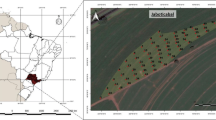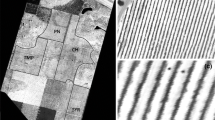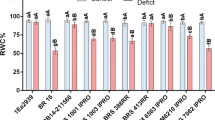Abstract
Although the information on the Normalized Difference Vegetation Index (NDVI) in plants under water deficit is often obtained from sensors attached to satellites, the increasing data acquisition with portable sensors has wide applicability in agricultural production because it is a fast, nondestructive method, and is less prone to interference problems. Thus, we carried out a set of experiments to investigate the influence of time, spatial plant arrangements, sampling size, height of the sensor and water regimes on NDVI readings in different soybean cultivars in greenhouse and field trials during the crop seasons 2011/12, 2012/13 and 2013/14. In experiments where plants were always evaluated under well-watered conditions, we observed that 9 a.m. was the most suitable time for NDVI readings regardless of the soybean cultivar, spatial arrangement or environment. Furthermore, there was no difference among NDVI readings in relation to the sampling size, regardless of the date or cultivar. We also observed that NDVI tended to decrease according to the higher height of the sensor in relation to the canopy top, with higher values tending to be at 0.8 m, but with no significant difference relative to 1.0 m—the height we adopted in our experiments. When different water regimes were induced under field conditions, NDVI readings measured at 9 a.m. by using a portable sensor were successful to differentiate soybean cultivars with contrasting responses to drought.









Similar content being viewed by others
References
Boller, W., Ferreira, M. C., & Costa, D. I. (2011). Condições do ar e angulação das folhas influenciam a qualidade das pulverizações na cultura da soja? Revista Plantio Direto, 121, 33–37.
Campos, H., Cooper, A., Habben, J. E., Edmeades, G. O., & Schussler, J. R. (2004). Improving drought tolerance in maize: A view from industry. Field Crops Research, 90, 19–34.
Carvalho, J. F. C., Crusiol, L. G. T., Perini, L. J., Sibaldelli, R. N. R., Ferreira, L. C., Marcelino-Guimaraes, F. C., et al. (2015). Phenotyping soybeans for drought responses using remote sensing techniques and non-destructive physiological analysis. Global Science and Technology, 8, 1–16.
Chaves, M. M., Maroco, J. P., & Pereira, J. S. (2003). Understanding plant responses to drought-from genes to the whole plant. Functional Plant Biology, 30, 239–264.
Chávez, R. O., Clevers, J. G. P. W., Verbesselt, J., Naulin, P. I., & Herold, M. (2014). Detecting leaf pulvinar movements on NDVI time series of desert trees: A new approach for water stress detection. PLoS One, 9, 1–12.
Chen, P. Y., Srinivasan, R., Fedosejevs, G., & Narasimhan, B. (2002). An automated cloud detection method for daily NOAA-14 AVHRR data for Texas, USA. International Journal of Remote Sensing, 23, 2939–2950.
Conab—National company of food supply (2016). Brazilian crop assessment—Grain, 2015/2016 crops, eight inventory survey, May/2016. Accessed July 08, 2016, from http://www.conab.gov.br/OlalaCMS/uploads/arquivos/16_05_27_09_24_04_boletim_graos_maio__2016_-_final.pdf.
Conab—National Company of Food Supply (2013). Brazilian crop assessment—Grain, 2012/2013 crops, twelfth inventory survey, September/2013. Accessed July 08, 2016, from http://www.conab.gov.br/OlalaCMS/uploads/arquivos/13_10_16_14_32_01_boletim_ingles_-_setembro_2013.pdf.
Conab—National Company of Food Supply (2014). Brazilian crop assessment—Grain, 2013/2014 crops, twelfth inventory survey, September/2014. Accessed July 08, 2016, from http://www.conab.gov.br/OlalaCMS/uploads/arquivos/14_09_10_14_35_09_boletim_graos_setembro_2014.pdf.
Dorman, M., Svoray, T., Perevolotsky, A., & Sarris, D. (2013). Forest performance during two consecutive drought periods: Diverging long-term trends and short-term responses along a climatic gradient. Forest Ecology and Management, 310, 1–9.
Embrapa Soja. (2013). Tecnologias de produção de soja – Região Central do Brasil 2014. Londrina: Embrapa Soja– Embrapa Cerrados – Embrapa Agropecuária Oeste.
Esquerdo, J. C. D. M., Zullo, J, Jr., & Antunes, J. F. G. (2011). Use of NDVI/AVHRR time-series profiles for soybean crop monitoring in Brazil. International Journal of Remote Sensing, 32, 3711–3727.
Fehr, W. R., & Caviness, C. E. (1977). Stages of soybean development. Special Report 80. Iowa: Iowa State University of Science and Technology.
Ferreira, D. F. (2010). SISVAR – Sistema de análise de variância. Versão 5.3. Lavras: UFLA.
Folhes, M. T., Rennó, C. D., & Soares, J. V. (2009). Remote sensing for irrigation water management in the semi-arid northeast of Brazil. Agricultural Water Management, 96, 1398–1408.
Gusso, A. (2013). Integração de imagens NOAA/AVHRR: Rede de cooperação para monitoramento nacional da safra de soja. Ceres, 60, 194–204.
Heatherly, L. G., & Elmore, T. W. (2004). Managing inputs for peak production. In J. E. Specht & H. R. Boerma (Eds.), Soybeans: Improvement, production and uses (pp. 451–536). Madison: ASA-CSSA-SSSA.
Hikishima, M., Canteri, M. G., Godoy, C. V., Koga, L. J., & Silva, A. J. (2010). Relationships among disease intensity, canopy reflectance and grain yield in the Asian soybean rust pathosystem. Tropical Plant Pathology, 35, 96–103.
Kim, K., & Chavas, J. P. (2003). Technological change and risk management: An application to the economics of corn production. Agricultural Economics, 29, 125–142.
Koundauri, P., Nauges, C., & Tzouvelekas, V. (2006). Technology adoption under production uncertainty: theory and application to irrigation technology. American Journal of Agricultural Economics, 88, 657–670.
Lawlor, D. W. (2013). Genetic engineering to improve plant performance under drought: physiological evaluation of achievements, limitations and possibilities. Journal of Experimental Botany, 63, 695–709.
Levitt, J. (1972). Responses of plants to environmental stresses. New York: Academic Press.
Marti, J., Bort, J., Slafer, G. A., & Araus, J. L. (2007). Can wheat yield be assessed by early measurements of Normalized Difference Vegetation Index? Annals of Applied Biology, 150, 253–257.
Mengistu, A., Tachibana, H., Epstein, A. H., Bidne, K. G., & Hatfield, J. D. (1987). Use of canopy temperature to measure the effects of brown stem rot and soil moisture stress and its relation to yields of soybean. Plant Disease, 71, 632–634.
Monteiro, P. F. C., Angulo Filho, R., Xavier, A. C., & Monteiro, R. O. C. (2012). Assessing biophysical variable parameters of bean crop with hyperspectral measurements. Scientia Agricola, 69, 87–94.
Mullan, D. J., & Reynolds, M. P. (2010). Quantifying genetic effects of ground cover on soil water evaporation using digital imaging. Functional Plant Biology, 37, 703–712.
Oya, T., Nepomuceno, A. L., Neumaier, N., Farias, J. R. B., Tobita, S., & Ito, O. (2004). Drought tolerance characteristics of brazilian soybean cultivars—evaluation and characterization of drought tolerance of various Brazilian soybean cultivars in the field. Plant Production Science, 7, 129–137.
Rakocevic, M., Neumaier, N., Oliveira, G. M., Nepomuceno, A. L., & Farias, J. R. B. (2010). Heliotropic responses of soybean cultivars at three phenological stages and under two water regimes. Pesquisa Agropecuária Brasileira, 45, 661–670.
Rao, T. V. R. (1985). Monitoring water stress in soybeans with remote sensing techniques. Lincoln: University of Nebraska.
Rosa, L. M., & Forseth, I. N. (1996). Diurnal patterns of soybean leaf inclination angles and azimuthal orientation under different levels of ultraviolet-B radiation. Agricultural and Forest Meteorology, 78, 107–119.
Rouse, J. W., Haas, R. H., Schell, J. A., Deering, D. W., Harlan, J. C. (1974). Monitoring the vernal advancement and retrogradation (green wave effect) of natural vegetation. Accessed July 8, 2016, from http://archive.org/details/nasa_techdoc_19740022555.
Royo, C., Aparicio, N., Villegas, D., Casadesus, J., Monneveux, P., & Araus, J. L. (2003). Usefulness of spectral reflectance indices as durum wheat yield predictors under contrasting Mediterranean conditions. International Journal of Remote Sensing, 24, 4403–4419.
Rulinda, C. M., Dilo, A., Bijker, W., & Stein, A. (2012). Characterising and quantifying vegetative drought in East Africa using fuzzy modelling and NDVI data. Journal of Arid Environments, 78, 169–178.
Samseemoung, G., Soni, P., Jayasuriya, H. P. W., & Salokhe, V. M. (2012). Application of low altitude remote sensing (LARS) platform for monitoring crop growth and weed infestation in a soybean plantation. Precision Agriculture, 13, 611–627.
Seversike, T. M., Sermons, S. M., Sinclair, T. R., Carter, T. E, Jr., & Rufty, T. W. (2013). Temperature interactions with transpiration response to vapor pressure deficit among cultivated and wild soybean genotypes. Physiologia Plantarum, 148, 62–73.
Sruthi, S., & Mohammed Aslam, M. A. (2015). Agricultural drought analysis using the NDVI and land surface temperature data; a case study of Raichur district. Aquatic Procedia, 4, 1258–1264.
Steven, M. D. (1993). Satellite remote sensing for agricultural management: Opportunities and logistic constraints. ISPRS Journal of Photogrammetry and Remote Sensing, 48, 29–34.
Thornthwaite, C. W., & Mather, J. R. (1955). The water balance. Centerton: Laboratory of Climatology.
Wilson, K. B., & Bunce, J. A. (1997). Effects of carbon dioxide concentration on the interactive effects of temperature and water vapour on stomatal conductance in soybean. Plant, Cell and Environment, 20, 230–238.
Wright, D. L, Jr., Rasmussen, V. P, Jr., & Ramsey, R. D. (2005). Comparing the use of remote sensing with traditional techniques to detect nitrogen stress in wheat. Geocarto International, 20, 63–68.
Xavier, A. C., Rudorff, B. F. T., Moreira, M. A., Alvarenga, B. S., Freitas, J. G., & Salomon, M. V. (2006). Hyperspectral field reflectance measurements to estimate wheat grain yield and plant height. Scientia Agricola, 63, 130–138.
Yuhas, A. N., & Scuderi, L. A. (2009). MODIS-derived NDVI characterization of drought-induced evergreen dieoff in Western North America. Geographical Research, 47, 34–45.
Zhang, F., Zhang, L. W., Wang, X. Z., & Hung, J. F. (2013). Detecting agro-droughts in Southwest of China using MODIS satellite data. Journal of Integrative Agriculture, 12, 159–168.
Acknowledgments
We thank the Coordination for the Improvement of Higher Education Personnel (CAPES) for granting the scholarship to the postdoctoral fellow JFC Carvalho and the National Council for Scientific and Technological Development (CNPq) for granting the scholarships to the students LGT Crusiol (PIBIC), W Neiverth (DTI-C), A Rio (DTI-C) and LC Ferreira (postdoctoral fellow). This paper was approved for publication by the Editorial Board of Embrapa Soybean as manuscript number 22/2015.
Author information
Authors and Affiliations
Corresponding author
Electronic supplementary material
Below is the link to the electronic supplementary material.
Rights and permissions
About this article
Cite this article
Crusiol, L.G.T., Carvalho, J.d.F.C., Sibaldelli, R.N.R. et al. NDVI variation according to the time of measurement, sampling size, positioning of sensor and water regime in different soybean cultivars. Precision Agric 18, 470–490 (2017). https://doi.org/10.1007/s11119-016-9465-6
Published:
Issue Date:
DOI: https://doi.org/10.1007/s11119-016-9465-6




